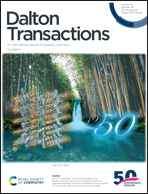Influence of F-position and solvent on coordination geometry and single ion magnet behavior of Co(ii) complexes†
Abstract
Three mononuclear Co(II) complexes with the compositions of [Co(L1)2] (1), [Co(L2)2(CH3CN)] (2) and [Co(L3)2] (3) (HL1 = 2-((E)-(2-fluorobenzylimino)methyl)-4,6-dibromophenol, HL2 = 2-((E)-(3-fluorobenzylimino)methyl)-4,6-dibromophenol and HL3 = 2-((E)-(4-fluorobenzylimino)methyl)-4,6-dibromophenol) were prepared and structurally determined. The changes in the F-positions in the ligands and solvents led to the formation of these products with various coordination geometries. Both complexes 1 and 3 are four-coordinated and their coordination geometries can be described as tetrahedron and seesaw, whereas complex 2 is five coordinated with a coordination configuration in between trigonal bipyramid and square pyramid. Static magnetic studies reveal that all these complexes exhibit considerable easy-axis magnetic anisotropy. The easy-axis magnetic anisotropy of 1 and 3 mainly derives from the first quartet excited state, whereas that of 2 primarily originates from the first, third and fourth quartet excited states established by theoretical calculations. All the resulting complexes display field-induced slow magnetic relaxation. Complex 3 represents the first Co(II) single ion magnet with a seesaw coordination geometry. Ab initio calculations predict that the magnetic anisotropy will enhance when the seesaw coordination geometry varies from distortion to regulation.



 Please wait while we load your content...
Please wait while we load your content...